CHEVROLET AVEO 2002 Service Repair Manual
Manufacturer: CHEVROLET, Model Year: 2002, Model line: AVEO, Model: CHEVROLET AVEO 2002Pages: 5127, PDF Size: 41.82 MB
Page 1621 of 5127
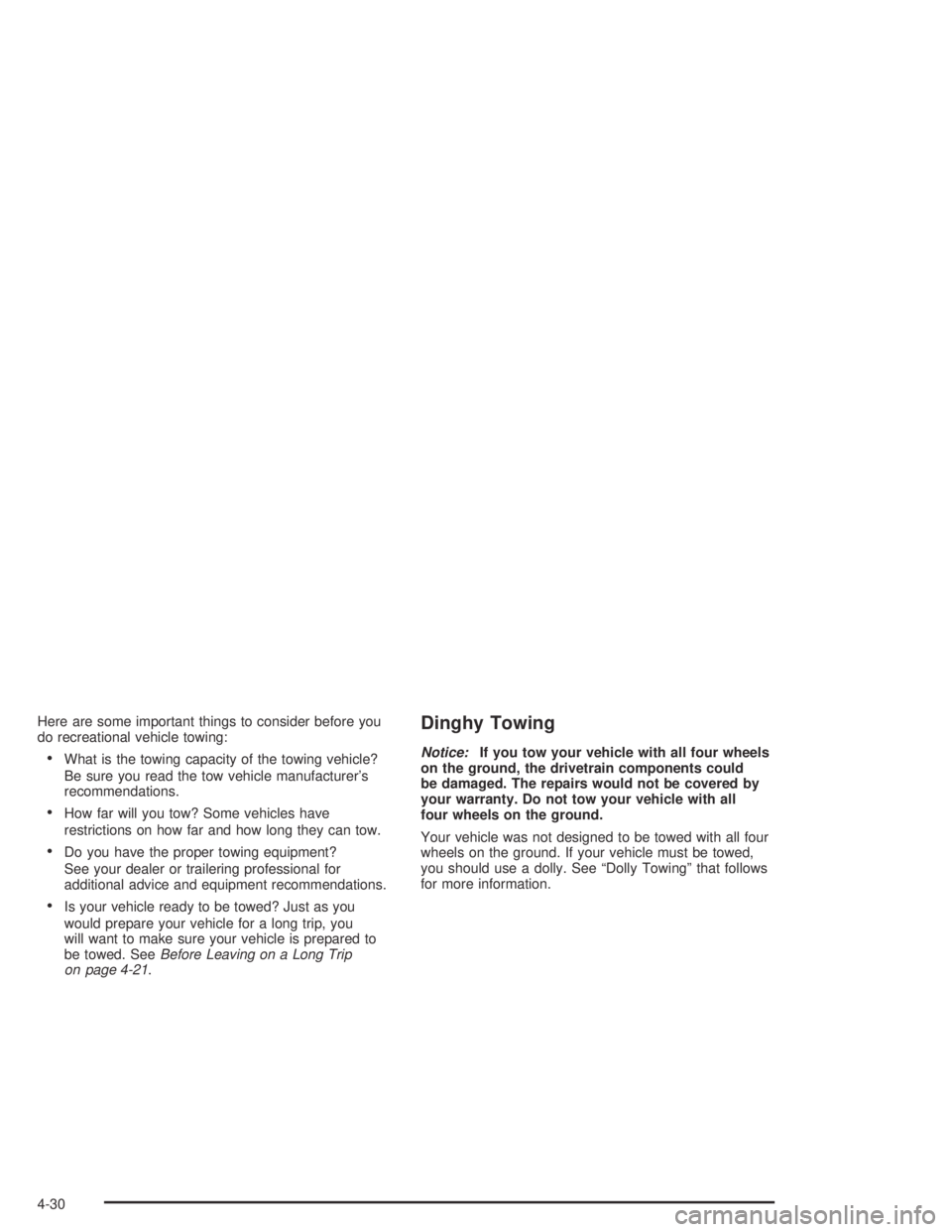
Here are some important things to consider before you
do recreational vehicle towing:
•What is the towing capacity of the towing vehicle?
Be sure you read the tow vehicle manufacturer’s
recommendations.
•How far will you tow? Some vehicles have
restrictions on how far and how long they can tow.
•Do you have the proper towing equipment?
See your dealer or trailering professional for
additional advice and equipment recommendations.
•Is your vehicle ready to be towed? Just as you
would prepare your vehicle for a long trip, you
will want to make sure your vehicle is prepared to
be towed. SeeBefore Leaving on a Long Trip
on page 4-21.
Dinghy Towing
Notice:If you tow your vehicle with all four wheels
on the ground, the drivetrain components could
be damaged. The repairs would not be covered by
your warranty. Do not tow your vehicle with all
four wheels on the ground.
Your vehicle was not designed to be towed with all four
wheels on the ground. If your vehicle must be towed,
you should use a dolly. See “Dolly Towing” that follows
for more information.
4-30
Page 1622 of 5127
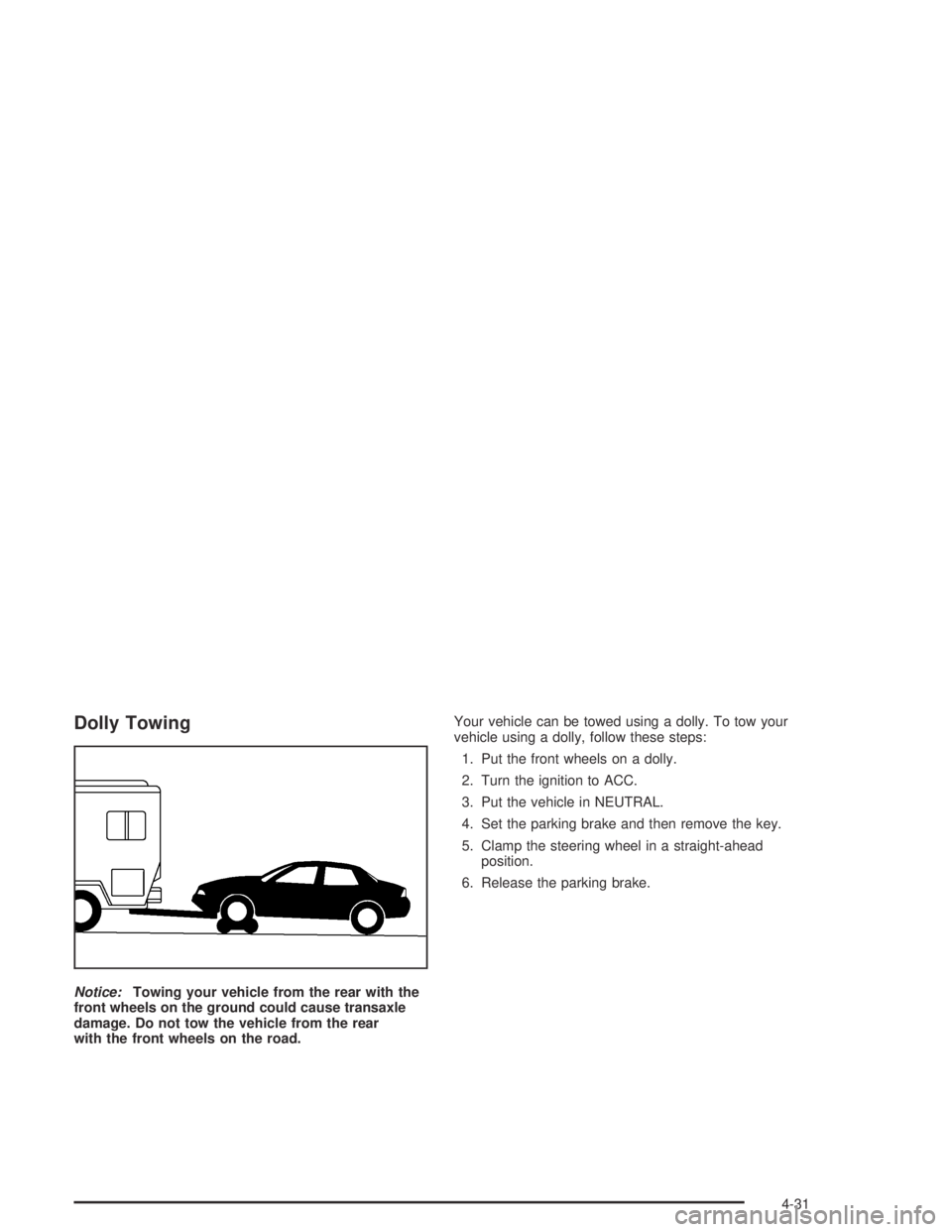
Dolly Towing
Notice:Towing your vehicle from the rear with the
front wheels on the ground could cause transaxle
damage. Do not tow the vehicle from the rear
with the front wheels on the road.Your vehicle can be towed using a dolly. To tow your
vehicle using a dolly, follow these steps:
1. Put the front wheels on a dolly.
2. Turn the ignition to ACC.
3. Put the vehicle in NEUTRAL.
4. Set the parking brake and then remove the key.
5. Clamp the steering wheel in a straight-ahead
position.
6. Release the parking brake.
4-31
Page 1623 of 5127
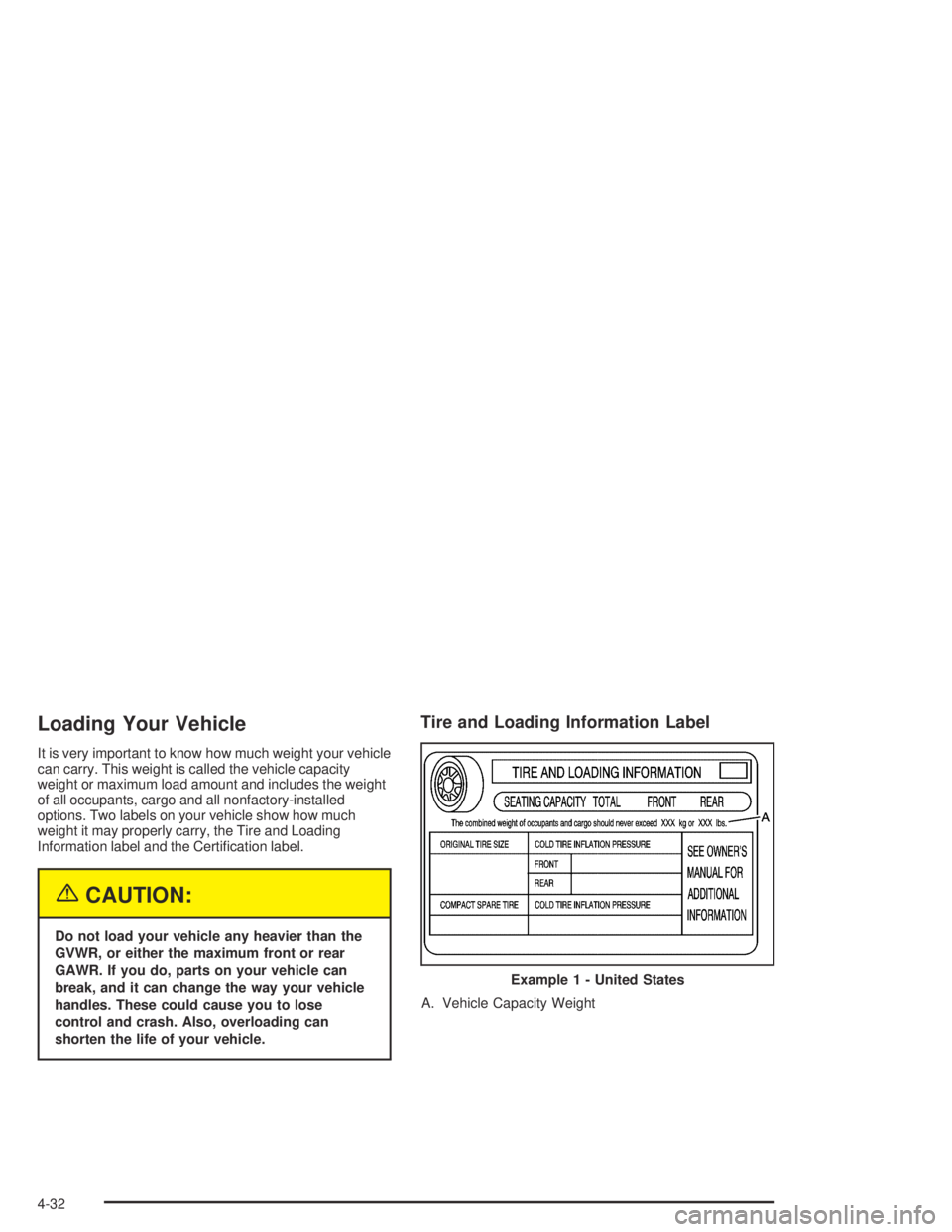
Loading Your Vehicle
It is very important to know how much weight your vehicle
can carry. This weight is called the vehicle capacity
weight or maximum load amount and includes the weight
of all occupants, cargo and all nonfactory-installed
options. Two labels on your vehicle show how much
weight it may properly carry, the Tire and Loading
Information label and the Certification label.
{CAUTION:
Do not load your vehicle any heavier than the
GVWR, or either the maximum front or rear
GAWR. If you do, parts on your vehicle can
break, and it can change the way your vehicle
handles. These could cause you to lose
control and crash. Also, overloading can
shorten the life of your vehicle.
Tire and Loading Information Label
A. Vehicle Capacity WeightExample 1 - United States
4-32
Page 1624 of 5127

The Tire and Loading Information label shows your
vehicle’s seating capacity, the total weight it can properly
carry and the original equipment tire size and the
recommended cold tire inflation pressure for those tires.
For more information on tires and inflation seeTires
on page 5-51andInflation - Tire Pressure on page 5-59.
If your vehicle was purchased in the United States,
the Tire and Loading Information label, Example 1, is
attached to the driver’s side, center pillar, below the door
latch. Vehicles purchased in Canada, will find the Tire
and Loading Information label, Example 2, attached
to the inside of the glove compartment.
There is also important loading information on the
Certification label. It tells you the Gross Vehicle Weight
Rating (GVWR) and the Gross Axle Weight Rating
(GAWR) for the front and rear axle; see “Certification
Label” later in this section.
Example 2 - Canada
4-33
Page 1625 of 5127
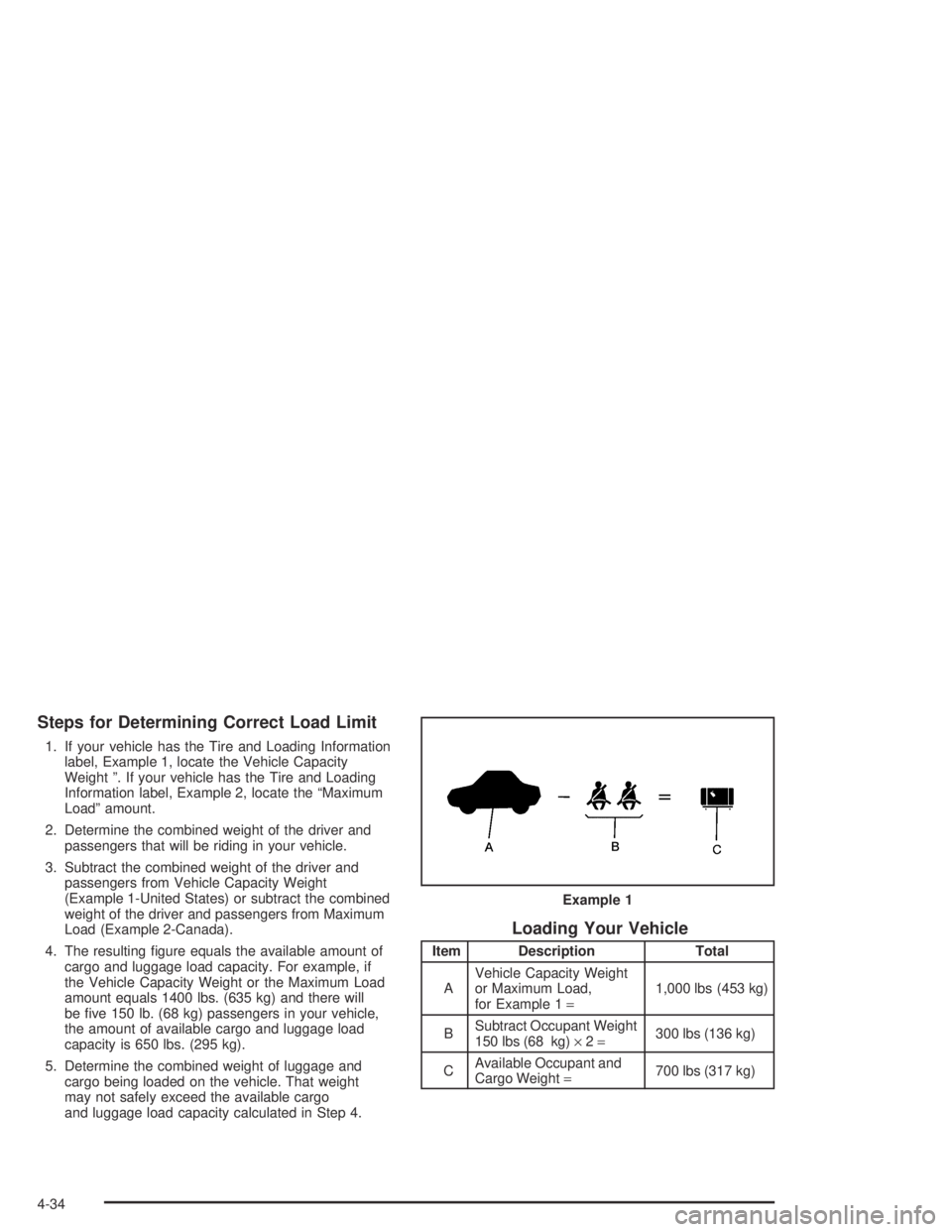
Steps for Determining Correct Load Limit
1. If your vehicle has the Tire and Loading Information
label, Example 1, locate the Vehicle Capacity
Weight ”. If your vehicle has the Tire and Loading
Information label, Example 2, locate the “Maximum
Load” amount.
2. Determine the combined weight of the driver and
passengers that will be riding in your vehicle.
3. Subtract the combined weight of the driver and
passengers from Vehicle Capacity Weight
(Example 1-United States) or subtract the combined
weight of the driver and passengers from Maximum
Load (Example 2-Canada).
4. The resulting figure equals the available amount of
cargo and luggage load capacity. For example, if
the Vehicle Capacity Weight or the Maximum Load
amount equals 1400 lbs. (635 kg) and there will
be five 150 lb. (68 kg) passengers in your vehicle,
the amount of available cargo and luggage load
capacity is 650 lbs. (295 kg).
5. Determine the combined weight of luggage and
cargo being loaded on the vehicle. That weight
may not safely exceed the available cargo
and luggage load capacity calculated in Step 4.
Loading Your Vehicle
Item Description Total
AVehicle Capacity Weight
or Maximum Load,
for Example 1=1,000 lbs (453 kg)
BSubtract Occupant Weight
150 lbs (68 kg)×2=300 lbs (136 kg)
CAvailable Occupant and
Cargo Weight=700 lbs (317 kg) Example 1
4-34
Page 1626 of 5127
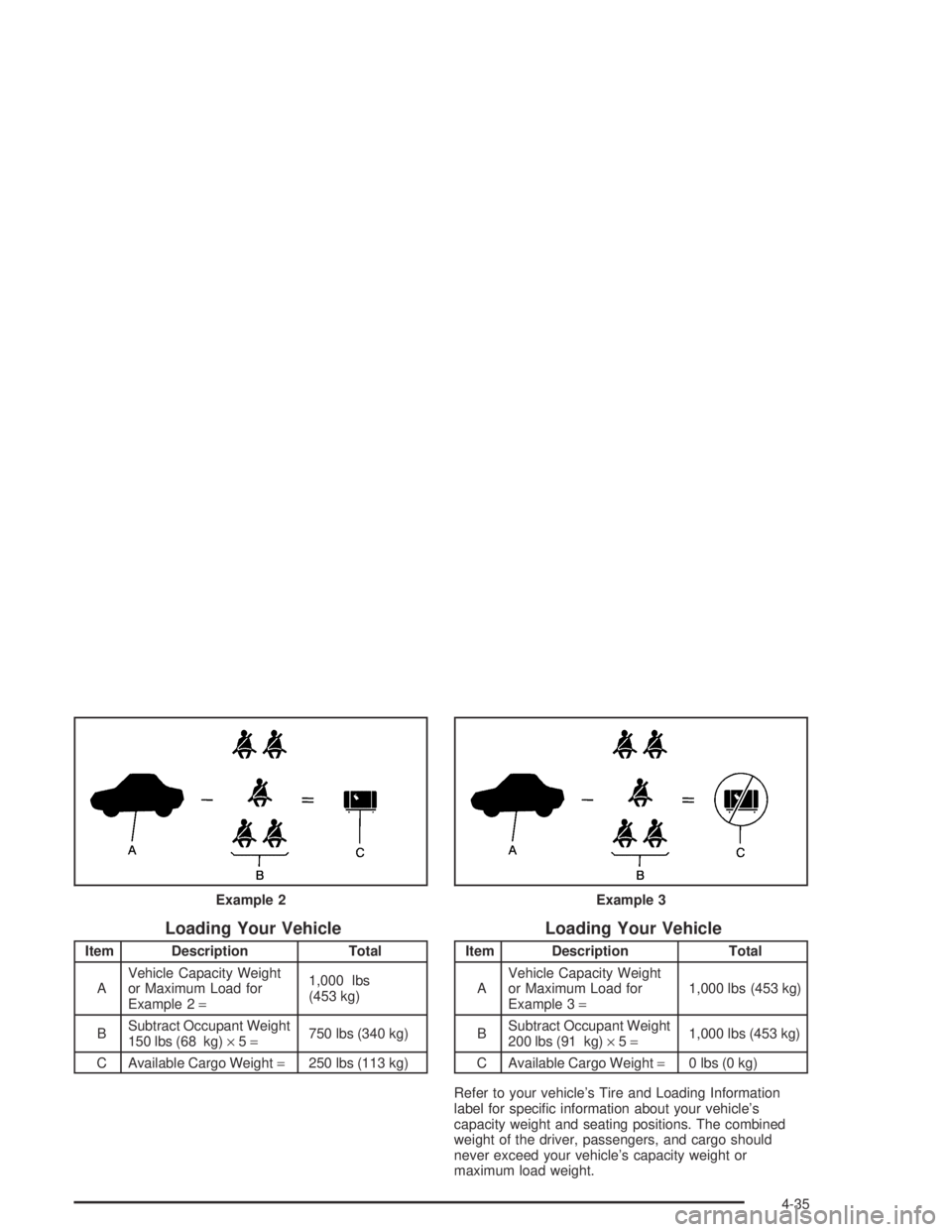
Loading Your Vehicle
Item Description Total
AVehicle Capacity Weight
or Maximum Load for
Example 2=1,000 lbs
(453 kg)
BSubtract Occupant Weight
150 lbs (68 kg)×5=750 lbs (340 kg)
C Available Cargo Weight=250 lbs (113 kg)
Loading Your Vehicle
Item Description Total
AVehicle Capacity Weight
or Maximum Load for
Example 3=1,000 lbs (453 kg)
BSubtract Occupant Weight
200 lbs (91 kg)×5=1,000 lbs (453 kg)
C Available Cargo Weight=0 lbs (0 kg)
Refer to your vehicle’s Tire and Loading Information
label for specific information about your vehicle’s
capacity weight and seating positions. The combined
weight of the driver, passengers, and cargo should
never exceed your vehicle’s capacity weight or
maximum load weight. Example 2
Example 3
4-35
Page 1627 of 5127

Certi�cation Label
The Certification label, found either on the center pillar,
near the Tire and Loading Information label or on
the end of the driver’s door, tells you the gross weight
capacity of your vehicle, called the Gross Vehicle Weight
Rating (GVWR). The GVWR includes the weight of
the vehicle, all occupants, fuel and cargo. Never exceed
the GVWR for your vehicle, or the Gross Axle Weight
Rating (GAWR) for either the front or rear axle. United States
Canada
4-36
Page 1628 of 5127
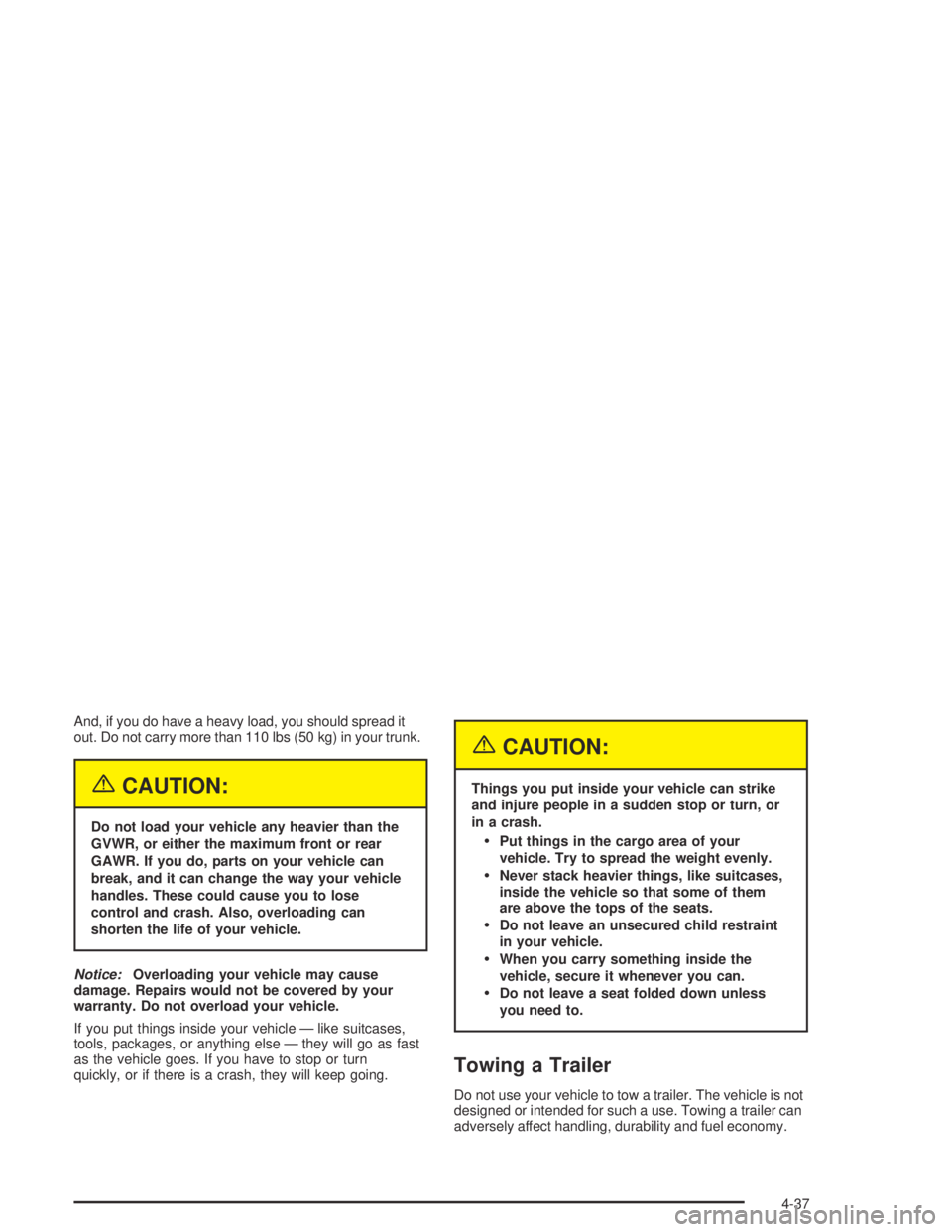
And, if you do have a heavy load, you should spread it
out. Do not carry more than 110 lbs (50 kg) in your trunk.
{CAUTION:
Do not load your vehicle any heavier than the
GVWR, or either the maximum front or rear
GAWR. If you do, parts on your vehicle can
break, and it can change the way your vehicle
handles. These could cause you to lose
control and crash. Also, overloading can
shorten the life of your vehicle.
Notice:Overloading your vehicle may cause
damage. Repairs would not be covered by your
warranty. Do not overload your vehicle.
If you put things inside your vehicle — like suitcases,
tools, packages, or anything else — they will go as fast
as the vehicle goes. If you have to stop or turn
quickly, or if there is a crash, they will keep going.
{CAUTION:
Things you put inside your vehicle can strike
and injure people in a sudden stop or turn, or
in a crash.
Put things in the cargo area of your
vehicle. Try to spread the weight evenly.
Never stack heavier things, like suitcases,
inside the vehicle so that some of them
are above the tops of the seats.
Do not leave an unsecured child restraint
in your vehicle.
When you carry something inside the
vehicle, secure it whenever you can.
Do not leave a seat folded down unless
you need to.
Towing a Trailer
Do not use your vehicle to tow a trailer. The vehicle is not
designed or intended for such a use. Towing a trailer can
adversely affect handling, durability and fuel economy.
4-37
Page 1629 of 5127

✍NOTES
4-38
Page 1630 of 5127
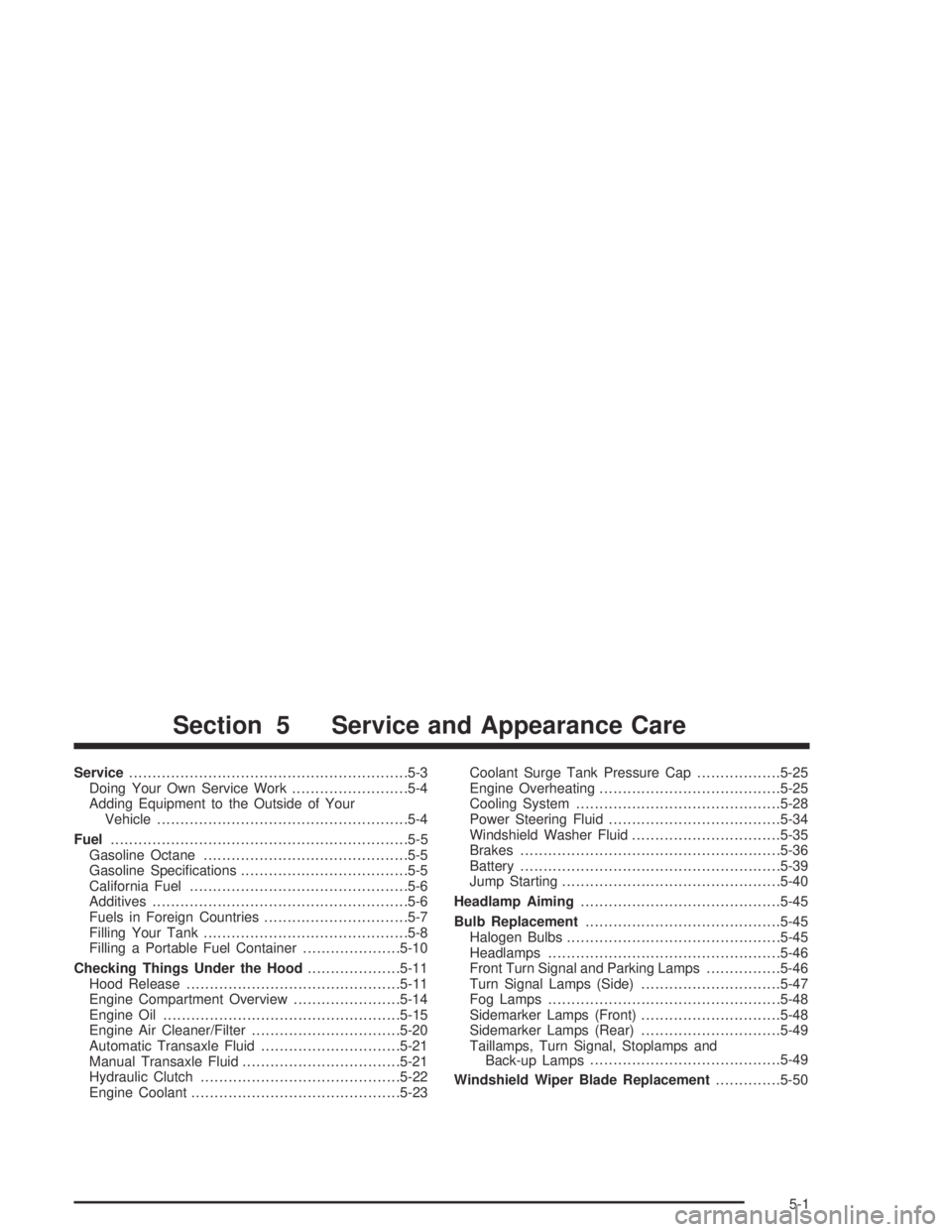
Service............................................................5-3
Doing Your Own Service Work.........................5-4
Adding Equipment to the Outside of Your
Vehicle......................................................5-4
Fuel................................................................5-5
Gasoline Octane............................................5-5
Gasoline Specifications....................................5-5
California Fuel...............................................5-6
Additives.......................................................5-6
Fuels in Foreign Countries...............................5-7
Filling Your Tank............................................5-8
Filling a Portable Fuel Container.....................5-10
Checking Things Under the Hood....................5-11
Hood Release..............................................5-11
Engine Compartment Overview.......................5-14
Engine Oil...................................................5-15
Engine Air Cleaner/Filter................................5-20
Automatic Transaxle Fluid..............................5-21
Manual Transaxle Fluid..................................5-21
Hydraulic Clutch...........................................5-22
Engine Coolant.............................................5-23Coolant Surge Tank Pressure Cap..................5-25
Engine Overheating.......................................5-25
Cooling System............................................5-28
Power Steering Fluid.....................................5-34
Windshield Washer Fluid................................5-35
Brakes........................................................5-36
Battery........................................................5-39
Jump Starting...............................................5-40
Headlamp Aiming...........................................5-45
Bulb Replacement..........................................5-45
Halogen Bulbs..............................................5-45
Headlamps..................................................5-46
Front Turn Signal and Parking Lamps................5-46
Turn Signal Lamps (Side)..............................5-47
Fog Lamps..................................................5-48
Sidemarker Lamps (Front)..............................5-48
Sidemarker Lamps (Rear)..............................5-49
Taillamps, Turn Signal, Stoplamps and
Back-up Lamps.........................................5-49
Windshield Wiper Blade Replacement..............5-50
Section 5 Service and Appearance Care
5-1